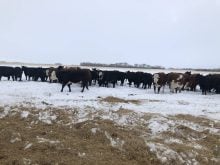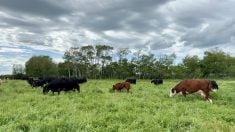From a management perspective, this past winter has been unusual, to say the least! It seems at every turn, beef producers across the country faced unexpected challenges. Examples include the residual effects of flooding in the Abbotsford area, drought in Western Canada, extended periods of extremely cold weather and for some areas, near-record snowfall. All this is coupled with severe feed shortages and crazy-high feed prices. I almost forgot to mention the impact of COVID-19 on everyday life and in particular on beef prices (i.e. high retail prices vs. depressed fat cattle prices). I could go on, but I think you get the point. Simply put, managing cattle over the winter of 2021-22 has been like riding a roller coaster with one exception — there have been a lot more lows than highs! Unfortunately, as we move into spring, the impact of these events will have lingering effects on how we manage cattle. The following highlights areas of concern, starting with feeder cattle.
Read Also

What to know before you go to Agribition 2025
If you’re attending Agribition 2025, this is the place to find out about tickets, dates and what’s happening this year.
Likely one of the most frustrating aspects of this past winter for cattle feeders has been sourcing feed grains and/or protein supplements. For the first time in my memory, U.S. corn replaced barley as the primary feed grain for feedlots across Western Canada. This was a result of extremely short barley supplies and unprecedented pricing. At first glance, this substitution may not seem like an issue as corn has a higher net energy-for-gain value than barley. However, feedlots have needed to source additional protein, as corn has a lower crude protein content than barley. This increased demand for protein resulted in a run on DDGs and canola meal supplies, with prices in the case of wheat DDGs rising from $300 in the fall to current prices in the range of $500 a tonne. Corn pricing followed a similar trend, going from $380 or so a tonne in the fall to present-day prices that are close to $500 a tonne.
Regardless of price, supplies of both corn and protein supplements such as DDGs have been extremely tight due to limited local supply and in some cases due to logistics of importing from the United States. There have been reports of feedlots having to cut the amount of grain fed to cattle, simply because they did not have a consistent supply. In other cases, they had to switch from corn to barley and back again due to delivery issues. I have seen feedlots go without a protein supplement for extended periods, again due to inconsistent supply.
While good management and in some cases alternatives such as urea can help to minimize the impact of these events, one should not underestimate the long-term consequences on performance. This is particularly true when you couple feed supply variations with extreme cold, which gripped the central part of the country for a good part of winter. The net result is that performance very likely suffered and the cost of gain skyrocketed. Consider, for example, a custom backgrounder who feeds under contract. If cattle were contracted to gain 2.5 pounds a day over 150 days and actual gains were in the range of 2.0 to 2.25 pounds, then when closing out the contract, one is liable to be short 40 to 75 pounds. Similar comments apply to finishing lots, as interim weights are liable to be 50 to 75 pounds short of where they should be.
All of this points to a need to re-evaluate your 2021-22 feeding program. In the case of backgrounding cattle, do you need to move cattle to a higher-energy ration to make up for lost weight gain or do you change direction and target lighter cattle for grass? Feedlots will need to pay attention to implant programs as extended days on feed can result in cattle being without active implants at a critical stage of the feeding program. Marketing schedules are also liable to be out of sync, possibly necessitating the need to make adjustments as to when cattle are scheduled for processing, particularly if they are under contract.
Cow-calf operators have experienced similar but somewhat different challenges. Drought severely affected forage supply leading to adjustments in the feeding program that resulted in greater reliance on straw and other by product feeds. Coupled with extended periods of cold weather, it has been a challenge to maintain body condition as we head into calving season. I will refer you to my February and March columns to read about the importance of optimizing the nutrition of pregnant and lactating cows. Here, I will simply re-emphasize the need to develop an appropriate feeding program that maintains body condition going into calving and from calving through the breeding season, including close attention to appropriate mineral and vitamin supplementation.
In summary, the winter of 2021-22 has thrown more curves at Canadian beef producers than a 40-year-old left-handed pitcher for the New York Yankees. However, keep in mind that there is a saying along the lines that “adversity makes you stronger.” I am sure that this will be true for the Canadian beef industry; we can only hope it is true for Ukraine and its people, who at the time of writing are facing a horrific spring and what amounts to outright genocide.

















